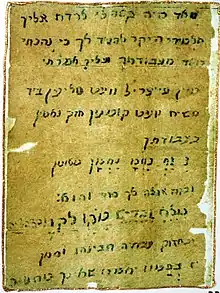Na Nach Nachma Nachman Meuman
Na Nach Nachma Nachman Me'uman (Hebrew: נַ נַחְ נַחְמָ נַחְמָן מְאוּמַן) is a Hebrew language name and song used by a subgroup of Breslover Hasidim colloquially known as the Na Nachs. It is a kabbalistic formula[1] based on the four Hebrew letters of the name Nachman, referring to the founder of the Breslov movement, Rebbe Nachman of Breslov, along with a reference to his burial place in Uman, Ukraine.

In 1922, Rabbi Yisroel Ber Odesser, a Breslover Hasid, claimed to have received a petek (note) addressed to him from Rebbe Nachman, although the latter had died in 1810. The seventh line of this petek is signed Na Nach Nachma Nachman Meuman, which became Rabbi Odesser's personal meditation and song. Before he died, he taught this phrase to a group of devotees who formed the Na Nach movement.
Rabbi Moshe Feinstein may have been referring to the petek in his endorsement of Odesser's book distribution ambition, stating that he saw a "wondrous secret document which he possesses".[2]
History of the phrase

The Na Nach Nachma phrase was "revealed" and taught by Rabbi Yisroel Ber Odesser, a well known Breslov figure who was born in 1888 in Tiberias. Odesser was among the first Breslover Hasidim in Israel, having learned about the movement from Rabbi Yisroel Halpern when he was a young yeshiva student.
When he was 33 years old, Odesser was overcome with weakness and hunger on the Fast of Tammuz. He decided to eat. But immediately after eating, he felt great sorrow at having succumbed to his own physical temptations. After five continuous days of prayer, a powerful thought came to him: "Go into your room!" He obeyed the inner voice, went to the bookcase, and randomly opened a book. In the book was a piece of paper that he would later call "The Letter from Heaven." The paper, written in Hebrew, with one line in Yiddish, is translated as follows:
It was very difficult for me to come down to you - מאוד היה קשה לי לרדת אליך
my precious student to tell you that I had pleasure - תלמידי היקר, להגיד לך כי נהנתי
very much from your devotion and upon you I said - מאוד מעבודתך, ועליך אמרתי
my fire will burn until - מיין פייערל וועט טליען ביז
Messiah is coming be strong and courageous - משיח וועט קומען חזק ואמץ
in your devotion - בעבודתך
Na Nach Nachma Nachman Meuman - נ נח נחמ נחמן מאומן
And with this I will reveal to you a secret and it is: - :ובזה אגלה לך סוד והוא
Full and heaped up from one extreme to another extreme (PTzPTzYH)[3] - מלא וגדיש מקו לקו (פצפציה)
And with the strengthening of your devotion you will understand it and a sign - ובחיזוק עבודה תבינהו וסמן
The 17th of Tammuz they will say that you don't fast - יז בתמוז יאמרו שאינך מתענה
Odesser believed the letter to be a message of consolation, directly from Rebbe Nachman's spirit to himself here on earth. Since his name did not appear in the petek as the recipient, Odesser said that this was reason for every person to consider the petek addressed to himself or herself personally.[4] Odesser adopted Na Nach Nachma Nachman Meuman[5] as his personal meditation and song, and became so totally identified with it that he later said, "I am Na Nach Nachma Nachman Me'Uman!" (This quote appears on Odesser's tombstone in Jerusalem.)
Authenticity of the petek

Some Breslover Hasidim, especially prevalent among followers of competing charismatic leaders, do not use Na Nach Nachma (some groups actually oppose it). Some deny its authenticity. The following are some of the diverse opinions:
- Rabbi Odesser believed the "Letter from Heaven" was a genuine miracle, pointing out that the bookcase where the petek (note) appeared was locked at the time, and he had the only key. His followers believed in the miracle also. They continue to this day to chant the phrase as a "Song of Redemption" for the freedom from sin and restoration of the world. Odesser's personal account of how he found the Letter has been translated into English under the title The Letter from Heaven: Rebbe Nachman's Song.
- Some believe that the letter was a note written to someone by Rebbe Nachman when he visited Tiberias during his pilgrimage to Israel in the early 19th century. Somehow it was placed in the old book, but Odesser's finding it was a coincidence (or miracle of timing), as was the reference to someone eating on the Fast of Tammuz.
- Still others believe it was a well-intentioned forgery, written by one of Rabbi Odesser's fellow students in order to cheer him up after he became depressed from breaking his fast.
Although Na Nach Nachma is based on the name of Rebbe Nachman, it was unknown in his day. However, he did say that repeating one word over and over was an effective form of meditation (Likutei Moharan Tinyana #96). His own personal phrase was Ribono shel Olam (Master of the Universe) which he pronounced with the Yiddish intonation as: Ree-BOY-noy shell OY-lahm. Many Breslover Hasidim today still prefer this phrase, although it refers to God, not the Zaddik.
Rabbi Moshe Feinstein
In the early 1980s, Rabbi Odesser met with Rabbi Moshe Feinstein, who had seen the petek and wished to meet its owner. At the meeting, Rabbi Feinstein asked Rabbi Odesser for a blessing, and Rabbi Feinstein also called in his wife to get a blessing from Rabbi Odesser. Rabbi Feinstein gave Rabbi Odesser the following approbation:[2]
I am writing on behalf of a most unusual individual, Rabbi Yisroel Dov Odesser, shlita, from Israel. This individual is a gaon in Torah. I had the pleasure of recently meeting with him. I saw a secret document he possesses; it is something very wondrous. Rabbi Odesser is soliciting funds to enable him to print Rabbi Nachman's sefarim, and it is a great mitzvah to assist him in this endeavor. Hashem will reward all those that so assist him.
Those who doubt the authenticity of the petek downplay Rabbi Feinstein's approbation by saying that he was known for his loving kindness and his desire to help people. They say that all Rabbi Feinstein wrote was that the petek was wondrous, but he didn't verify its authenticity.
Pronunciation and meaning of the phrase
During his lifetime, Rebbe Nachman spoke of a "Song of Redemption" that would be revealed before the coming of the Jewish Messiah. This song would be in a "single, double, triple, quadruple" form. (Likutei Moharan II, #8). The Na Nach Nachma phrase has such a structure (keeping in mind that Hebrew often omits the vowels) and is based on the Rebbe's name, "Nachman":
- Na (One Hebrew letter: Nun) — נ
- NaCH (Two Hebrew letters: Nun-Chet) — נח
- NaCHMa (Three Hebrew letters: Nun-Chet-Mem) — נחמ
- NaCHMaN (Four Hebrew letters: Nun-Chet-Mem-Nun) — נחמן
- Me'Uman (a double entendre: it can mean "from Uman", Rebbe Nachman's burial place, and can also mean "believed" or "accredited".) — מאומן
The phrase is pronounced with a soft A sound as in "ah" and a guttural KH sound as in German "ach." It is usually accented as follows:
Nah-nakh-nakhmah-nakhman-meh-oo-mahn.
Speakers of Yiddish have also noted that na nach can mean "now to," which would loosely translate the phrase as "Now to Nachman from Uman," that is, traveling to the Rebbe on pilgrimage to his gravesite or in one's heart.
Popularity of the phrase today
Whatever the origins of this phrase, it is now very popular among a subgroup group of Breslover Hasidim who follow Rabbi Odesser, who are colloquially known as the Na Nachs. The name has been incorporated into both traditional and contemporary Jewish music, appeared on bumper stickers, billboards and public graffiti throughout Israel, and is used on jewellery and amulets.
Among some groups of Sephardic Jewish youth in Israel, it has become a sort of rallying cry for returning to traditional Judaism, although not necessarily to mainstream Breslov.

More recently, some people have begun to wear the words of the phrase crocheted on large, white yarmulkes with a little tassel on top. (These hats are a modification of a traditional white yarmulke that has been worn in Jerusalem for centuries. That style, in turn, apparently evolved from the medieval Jewish hat with the ball on top — hence the tassel.) When Rabbi Odesser was still alive, some of his followers were already wearing large white yarmulkes, but without the phrase on them. Today, the Na Nachs make this crocheted yarmulke part of their uniform attire. Na Nach Nachma Nachman Meuman yarmulkes in other colors are also appearing on the market and are a popular item for Purim.
Bibliography
The following books were written on the petek and the meaning of its words:
- Matzpon Hapetek ("The Compass of the Petek"), by Amos Levi. This book divides the 6,000 years of the world by the 51 words of the petek, allocating 120 years to each word, analyzing history and the future based on the corresponding word and letters in the petek. E.g. the first word of the petek, Meod (very) corresponds to the first 120 years of the world. Thus the Hebrew letters of the word Meod, מאד, can be rearranged to spell Adam, אדם, the first person to live in those years.[upper-alpha 1]
- Seventy Rectifications of the Petek
- Zeh Yinachamainu ("This Will Comfort Us"), by Rabbi Yitzhak Besancon. An in-depth study of every word and letter of the petek.
References
- ם is the form the letter מ takes at the end of a word; Hebrew is written from right to left.
- "Achorayim" -- A progressive expansion of the name, one letter at a time
- http://www.zissil.com/topics/File:00000050-moshe-feinstein-haskama-petek-jpg
- This is the name of an angel in charge of the soundings of the shofar.
- Yisroel Saba tape recording and transcript.
- ...i.e. Nachman Song
Sources
| Wikisource has original text related to this article: |
- The Letter from Heaven: Rebbe Nachman's Song. an account of Rabbi Odesser's life and the story of the Na Nach Nachma, published by Netzach Yisroel Press, Israel, 1991, 1995.
- Young Buds of the Stream, letters to Zalman Shazar from Rabbi Odesser, English edition published by Netzach Yisroel Press, Israel 1995. Pages 37–43 contain a detailed explanation of the meaning of the phrase.
- Outpouring of the Soul, translated by Aryeh Kaplan. (Compilation of Nachman of Breslov's quotes on meditation and prayer). Breslov Research Institute, 1980.
External links
- Rabbi Yisroel Ber Odesser page—direct link to the section discussing the authenticity of the Letter from Heaven (including handwriting analysis, police lab analysis of the paper, etc.) and cites references to similar miraculous letters mentioned in the Talmud.
- NaNach.Net Current news about Na Nachs all over the world. Sabba Yisroel, the community, pictures, videos and articles about people shouting Na Nach Nachma Nachman Meuman!
- Haaretz, 5/25/08 Ha'aretz: Rolling with the Na Nachs, the most high-spirited and newest Hasidic sect
